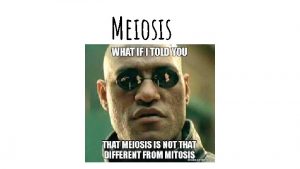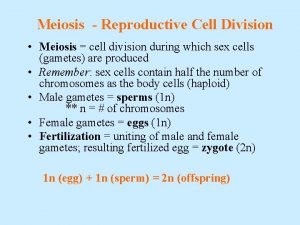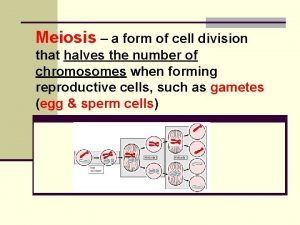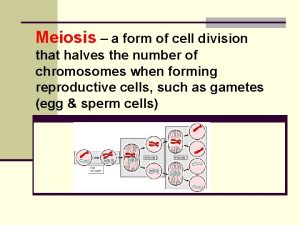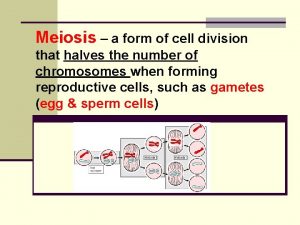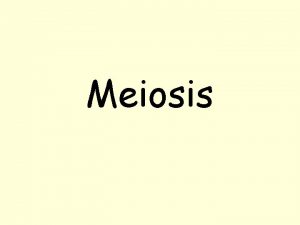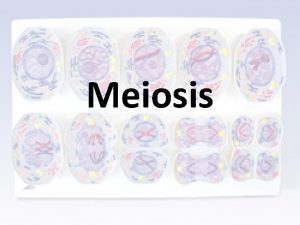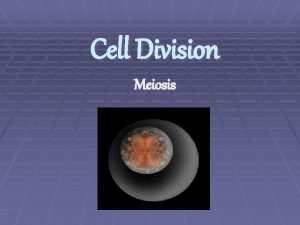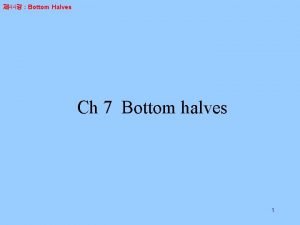Section 11 4 Meiosis cell division that halves












- Slides: 12

Section 11 -4: Meiosis – cell division that halves the number of chromosomes in new cells, making haploid cells *Recall, haploid cells in human are egg/sperm cells, called gametes, and contain 23 chromosomes.

Stages of Meiosis I. Interphase A. cells go through G 1, S, and G 2 phases; B. DNA is copied and cells grow larger.

II. Meiosis I A. Prophase I 1. DNA is coiled into chromosomes & nucleus breaks down 2. Centrioles move to ends of cell; spindle fibers appear 3. Chromosomes pair up (in homologous pairs) and twist together. – Portions of a chromatid can break off and reattach to the identical chromatid on its homologous chromosome = crossing over

Prophase I and Crossing Over

B. Metaphase I 1. Homologous chromosomes line up randomly in the center of the cell 2. Spindle fibers attach to the centromeres

C. Anaphase I 1. Spindle fibers pull homologous chromosomes apart. 2. The direction the chromosomes are pulled is random = independent assortment

D. Telophase I 1. Chromosomes move to opposite ends of the cell 2. Cytokinesis occurs **Meiosis I results in 2 new haploid cells

III. Meiosis II • Begins immediately after Meiosis I. • Both cells from Meiosis I go through Meiosis II. • DNA is not copied this time!!!!!!!

A. Prophase II – spindle fibers reform, centrioles move to opposite ends of cell B. Metaphase II – single chromosomes line up in the middle of the cell C. Anaphase II – spindle fibers attach at centromeres and pull chromatids apart D. Telophase II – chromatids move to opposite ends, and nucleus forms around them and cytokinesis occurs **Meiosis II results in 4 new Haploid cells.

Stages of Meiosis II

IV. Meiosis Forms Gametes A. The 4 haploid cells produced in Meiosis are gametes (sex cells = egg/sperm) B. Spermatogenesis – production of sperm cells C. Oogenesis – production of mature egg cells or ova (singular = ovum)

V. Genetic Variation in Meiosis A. Crossing Over – switching of DNA between chromatids of homologous pairs; occurs during prophase I B. Independent Assortment – each homologous pair is separated independent of how the other pairs are separated. C. Random Fertilization – of the 4 gametes produced in meiosis, any one can fertilize (join) with another gamete
 Cell division mitosis and meiosis
Cell division mitosis and meiosis Meiosis
Meiosis Section 10-2 cell division
Section 10-2 cell division Cell cycle and cell division
Cell cycle and cell division Mitosis
Mitosis Chapter 10 section 1 meiosis answer key
Chapter 10 section 1 meiosis answer key Phân độ lown
Phân độ lown Block xoang nhĩ là gì
Block xoang nhĩ là gì Thể thơ truyền thống
Thể thơ truyền thống Thơ thất ngôn tứ tuyệt đường luật
Thơ thất ngôn tứ tuyệt đường luật Walmart thất bại ở nhật
Walmart thất bại ở nhật Tìm vết của đường thẳng
Tìm vết của đường thẳng Hãy nói thật ít để làm được nhiều
Hãy nói thật ít để làm được nhiều













